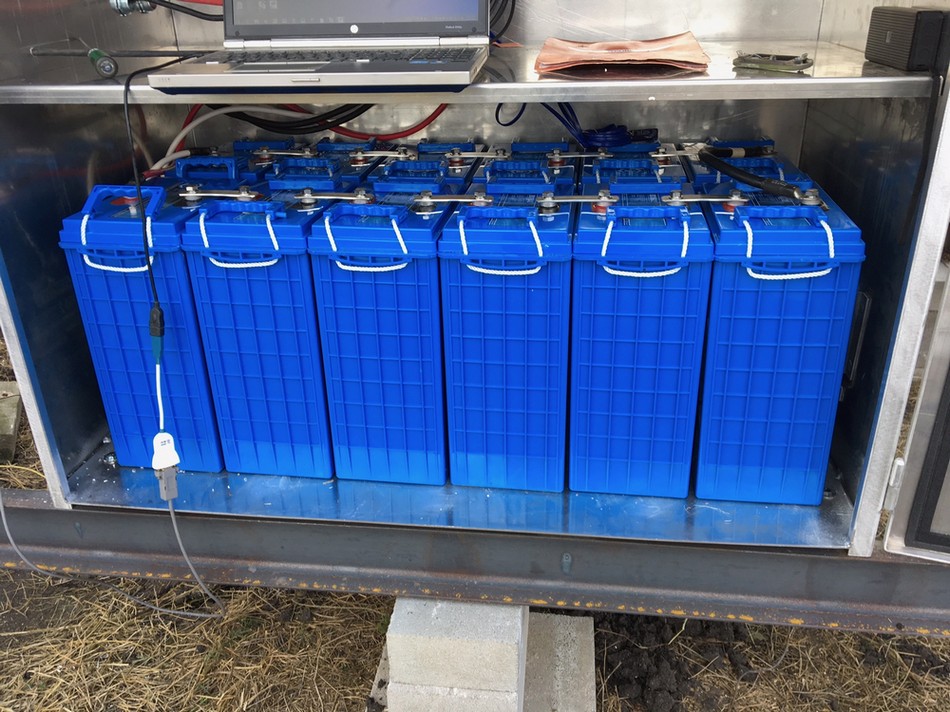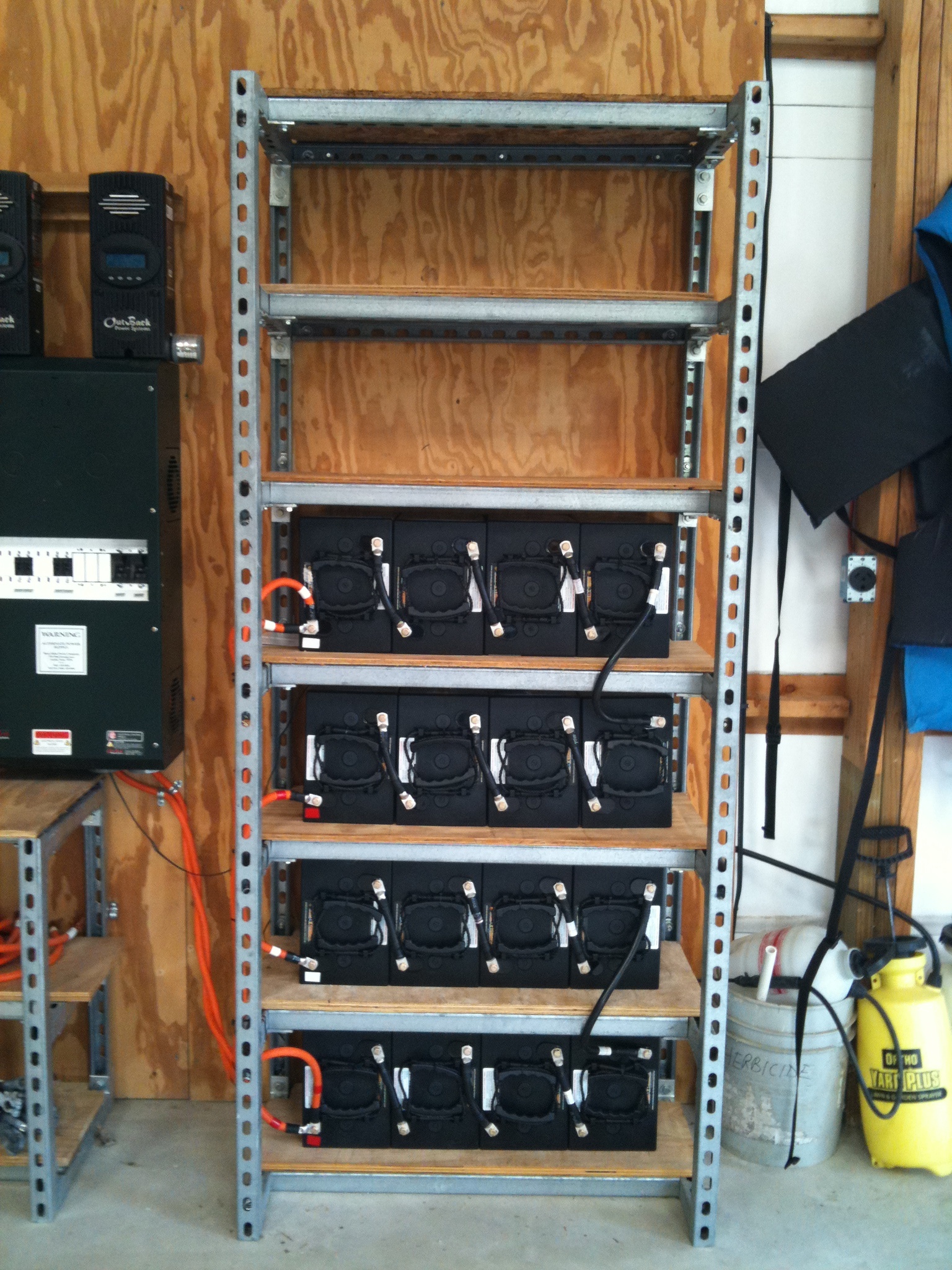2 Volt Batteries for 48 Volt System
Comments
-
For a 48v bank, you would wire them like you did for 12v, positive on one cell to negative on the next. All 24 cells are connected this way, and you should see 50-odd volts from one end of the string to the other.
Put another way, you connect the poitive of one 12v bank to the negative of the next.Off-grid.
Main system ~4kw panels into 2xMNClassic150 370ah 48v bank 2xOutback 3548 inverter 120v + 240v autotransformer
Night system ~1kw panels into 1xMNClassic150 700ah 12v bank morningstar 300w inverter -
Thanks Estragon for that
-
We have a solar engineer named Angelini that uses 2 volt cells. I'd try a search for a pic of one of his systems.
First Bank:16 180 watt Grape Solar with FM80 controller and 3648 Inverter....Fullriver 8D AGM solar batteries. Second Bank/MacGyver Special: 10 165(?) watt BP Solar with Renogy MPPT 40A controller/ and Xantrex C-35 PWM controller/ and Morningstar PWM controller...Cotek 24V PSW inverter....forklift and diesel locomotive batteries -
Hi billa,
We do not know all of the details of the physical layout of your system.
But, for a single string of batteries, in series, it can help reduce the total length of interconnects to make a U configuration with the batteries -- half of the batteries are run going away from the inverter/s, and the other half of the series connected batteries coming back toward the inverter/s.
Given that the batteries appear to be supplied with interconnecting busbars, for a U configuration you would probably need only one cable to connect the two halves of the battery bank together (at the end farthest away from the inverter, and or course, cables to connect the battery end terminals to the inverter/s.
Just one thought. Good Luck, Vic
Off Grid - Two systems -- 4 SW+ 5548 Inverters, Surrette 4KS25 1280 AH X2@48V, 11.1 KW STC PV, 4X MidNite Classic 150 w/ WBjrs, Beta KID on S-530s, MX-60s, MN Bkrs/Boxes. 25 KVA Polyphase Kubota diesel, Honda Eu6500isa, Eu3000is-es, Eu2000, Eu1000 gensets. Thanks Wind-Sun for this great Forum. -
I am a fan of bus bars between batteries in a row, making up a single string. This a 24v 1150 ah battery bank with 2v cells, but the concept is the same.

The picture below is an off grid cabin with (2) 48volt strings of 300ah 6v batteries, in parallel.
The original bottom eight were installed in Jan of 2009, the middle section was added in June 2010. Note the space for a third string on top, they were installed in early 2011 when the final A/C system was installed.
Note the same concept is used in this system for a very large home with 4 strings of (24) 1200 ah 2v cells with a total of 96 batteries in a 48v system. In this example, the 2v batteries have 4 connections. Two (+) and two (-) to allow a higher current flow if needed.
Marc
I always have more questions than answers. That's the nature of life. -
softdown said:^^^In the first photo, I would think those are tin plated copper bus bars? Great concept, interesting that such connections do not seem to be used real frequently. Seems that copper cable and lugs are the dominant connection.
I watched some footage of the battery array on a German WWII diesel-electric. It may have been the Type XXI with 250 tons of batteries. The bus bars were very thick and appeared to be lead due to their thickness. They were also completely exposed. Mechanics moved around on suspension equipment....hoping that they did not slip. Life used to be "cheap".
Considering the ~5% efficiency of lead connectivity....versus 100% for copper, lead bus bars would seem a questionable choice.
I think bus bars should be covered/insulated to the extent that is practical. I also believe in at least a 1" gap for battery heat to dissipate. I prefer 2" when doing my own. Seems that almost everybody simply packs their batteries in tight.
First Bank:16 180 watt Grape Solar with FM80 controller and 3648 Inverter....Fullriver 8D AGM solar batteries. Second Bank/MacGyver Special: 10 165(?) watt BP Solar with Renogy MPPT 40A controller/ and Xantrex C-35 PWM controller/ and Morningstar PWM controller...Cotek 24V PSW inverter....forklift and diesel locomotive batteries -
Good call, indeed they are tin plated copper. At $5.00 or $6.00 each, they are lower cost than the 2/0 or 4/0 cable sets they replace. We have the holes slotted to simplify installation.
I don't see a lot of heat buildup with AGM batteries with the charging current to battery bank capacity ratios typically seen with PV systems, but I do feel that space is always a good idea.
The rig in the first picture is one of 32 similar systems for pipelines and pump stations in TX, OK and Southern NM. The average service life is right at 7 years. The other two battery bank pictures are in air conditioned spaces, so I anticipate many years of service life remaining.
Marc
I always have more questions than answers. That's the nature of life. -
Marc.........I went over to Ebay to investigate copper bus bars. Looks like $5-$6 is a smoking deal. The sturdy ones seemed to run closer to $20. The cheaper ones were 1/16" thick and 3/8"-1/2" in height. I think that is generally far less than an optimal size. Unless, of course, one has a couple GC2 batteries on their small cabin system.
My findings to date is 3/4" copper plumbing pipe, available at hardware stores, makes a great bus bar with a little fab work. Unless I could find bus bars as pictured for $5-$6....
First Bank:16 180 watt Grape Solar with FM80 controller and 3648 Inverter....Fullriver 8D AGM solar batteries. Second Bank/MacGyver Special: 10 165(?) watt BP Solar with Renogy MPPT 40A controller/ and Xantrex C-35 PWM controller/ and Morningstar PWM controller...Cotek 24V PSW inverter....forklift and diesel locomotive batteries -
I've never seen a definitive answer about solid bus bars (vs something stranded) causing excessive terminal strain (from thermal movement) with lead acid batteries. I have a theory that a double layer of polyethylene plastic sheet under the battery would assist with allowing the batteries to slide, reducing such strain.
I am available for custom hardware/firmware development
-
Compared to the industry as a whole, my field of view is very limited and narrow - but I have not seen a single loose terminal on a project with bars in stationary applications. I will not apply them in mobile applications. I sell around 2,500 AGM's per year, and I would estimate that only about 15% to 20% of them have bus bar interconnects.
A narrow slice of experience - but 100% positive for 9 years.
Marc
I always have more questions than answers. That's the nature of life. -
I got some copper flat stock on Amazon a few years back very reasonably priced. They had it in various width and thicknesses.
I think it came in 3 ft. lengths and cuts easy with a hacksaw.
-
Solid bus bars eliminate the connective lugs and the consequent possible loss of some electrical continuity. Copper plumbing pipe claims to be 99.9% pure copper (at a major hardware chain). One can use 7/8" ID hose for insulation on 3/4" copper plumbing pipe. At ~ $2.50 foot, it is a cost efficient bus bar. Though one needs a large vice or a hammer to flatten the ends.mrfixit said:I got some copper flat stock on Amazon a few years back very reasonably priced. They had it in various width and thicknesses.
I think it came in 3 ft. lengths and cuts easy with a hacksaw.
I would prefer a flat ~ 3/16" x 3/4" bus bar. Not going to use 1/16" bus bar. Since I already have almost 400' of 4/0, that will likely be used for a bit.
I would think a carbide tipped circular saw blade would muscle through copper bar a few times. it would be interesting to know exactly how much damage would result.
FWIW.....a forum user previously wrote his findings on the resistance of 1/2" and 3/4" copper pipe.....and welding cable I think. The 3/4" copper pipe appeared to make a very good bus bar.
First Bank:16 180 watt Grape Solar with FM80 controller and 3648 Inverter....Fullriver 8D AGM solar batteries. Second Bank/MacGyver Special: 10 165(?) watt BP Solar with Renogy MPPT 40A controller/ and Xantrex C-35 PWM controller/ and Morningstar PWM controller...Cotek 24V PSW inverter....forklift and diesel locomotive batteries -
According to my calculations, flattened 1/2" type K copper pipe should be very close to 3/16" x 3/4" bar.
I am available for custom hardware/firmware development
-
I figured the pipe at 1/16" walls so 1/8" flattened. 3/16" would be 50% thicker. Could be wrong on the pipe thickness.jonr said:According to my calculations, flattened 1/2" type K copper pipe should be very close to 3/16" x 3/4" bar.
First Bank:16 180 watt Grape Solar with FM80 controller and 3648 Inverter....Fullriver 8D AGM solar batteries. Second Bank/MacGyver Special: 10 165(?) watt BP Solar with Renogy MPPT 40A controller/ and Xantrex C-35 PWM controller/ and Morningstar PWM controller...Cotek 24V PSW inverter....forklift and diesel locomotive batteries
Categories
- All Categories
- 233 Forum & Website
- 141 Solar Forum News and Announcements
- 1.4K Solar News, Reviews, & Product Announcements
- 199 Solar Information links & sources, event announcements
- 900 Solar Product Reviews & Opinions
- 256 Solar Skeptics, Hype, & Scams Corner
- 22.5K Solar Electric Power, Wind Power & Balance of System
- 3.5K General Solar Power Topics
- 6.7K Solar Beginners Corner
- 1K PV Installers Forum - NEC, Wiring, Installation
- 2.1K Advanced Solar Electric Technical Forum
- 5.6K Off Grid Solar & Battery Systems
- 429 Caravan, Recreational Vehicle, and Marine Power Systems
- 1.1K Grid Tie and Grid Interactive Systems
- 656 Solar Water Pumping
- 816 Wind Power Generation
- 624 Energy Use & Conservation
- 623 Discussion Forums/Café
- 315 In the Weeds--Member's Choice
- 75 Construction
- 125 New Battery Technologies
- 108 Old Battery Tech Discussions
- 3.8K Solar News - Automatic Feed
- 3.8K Solar Energy News RSS Feed
